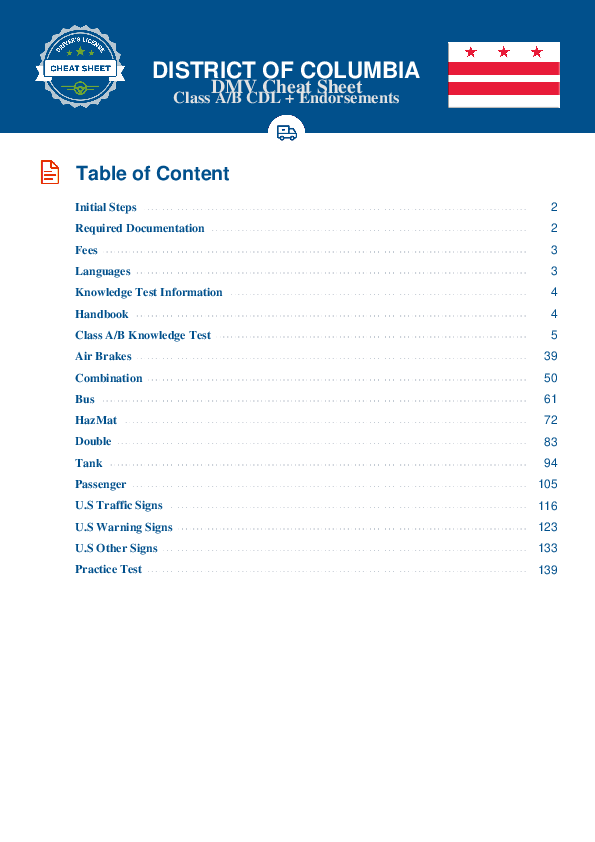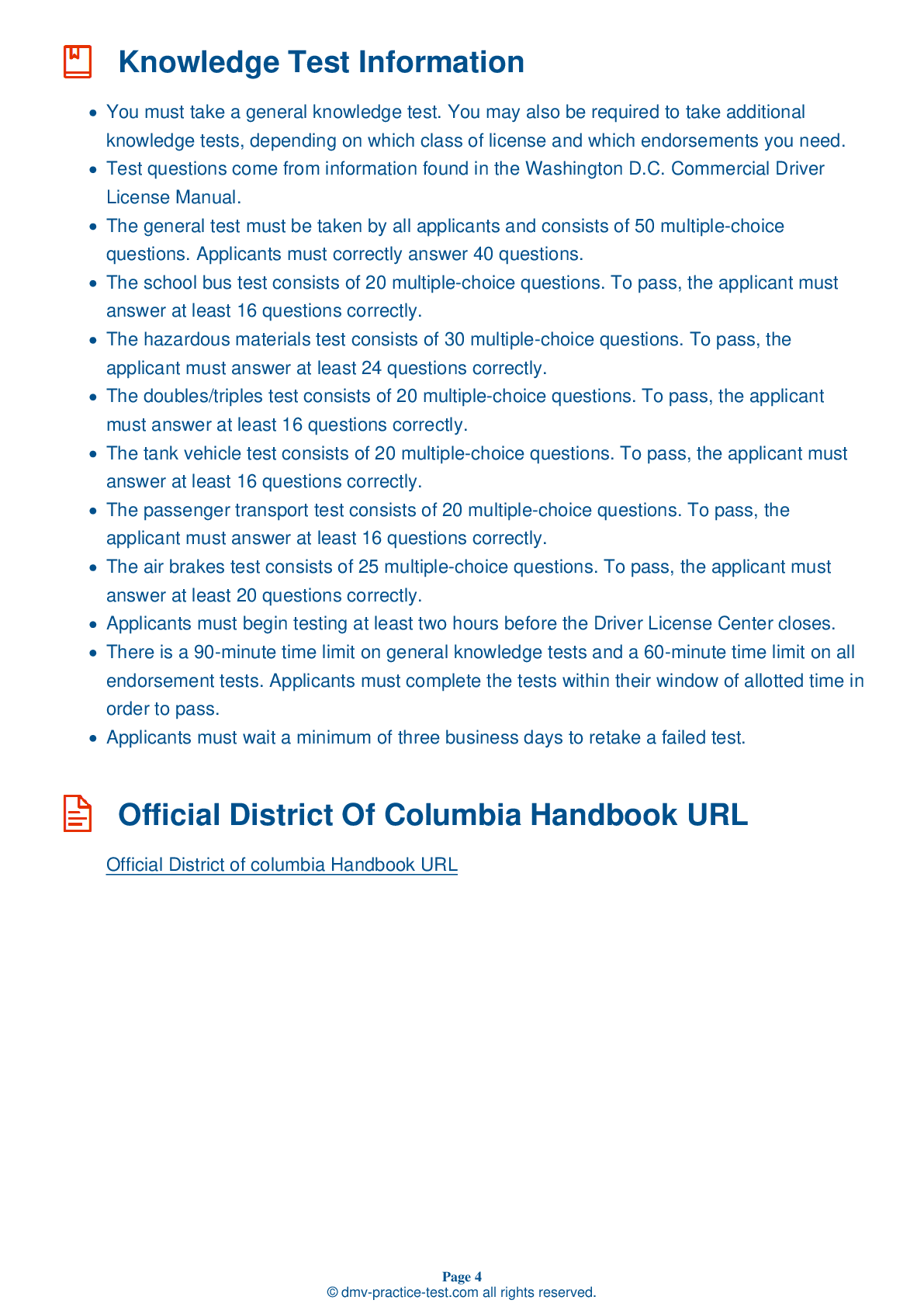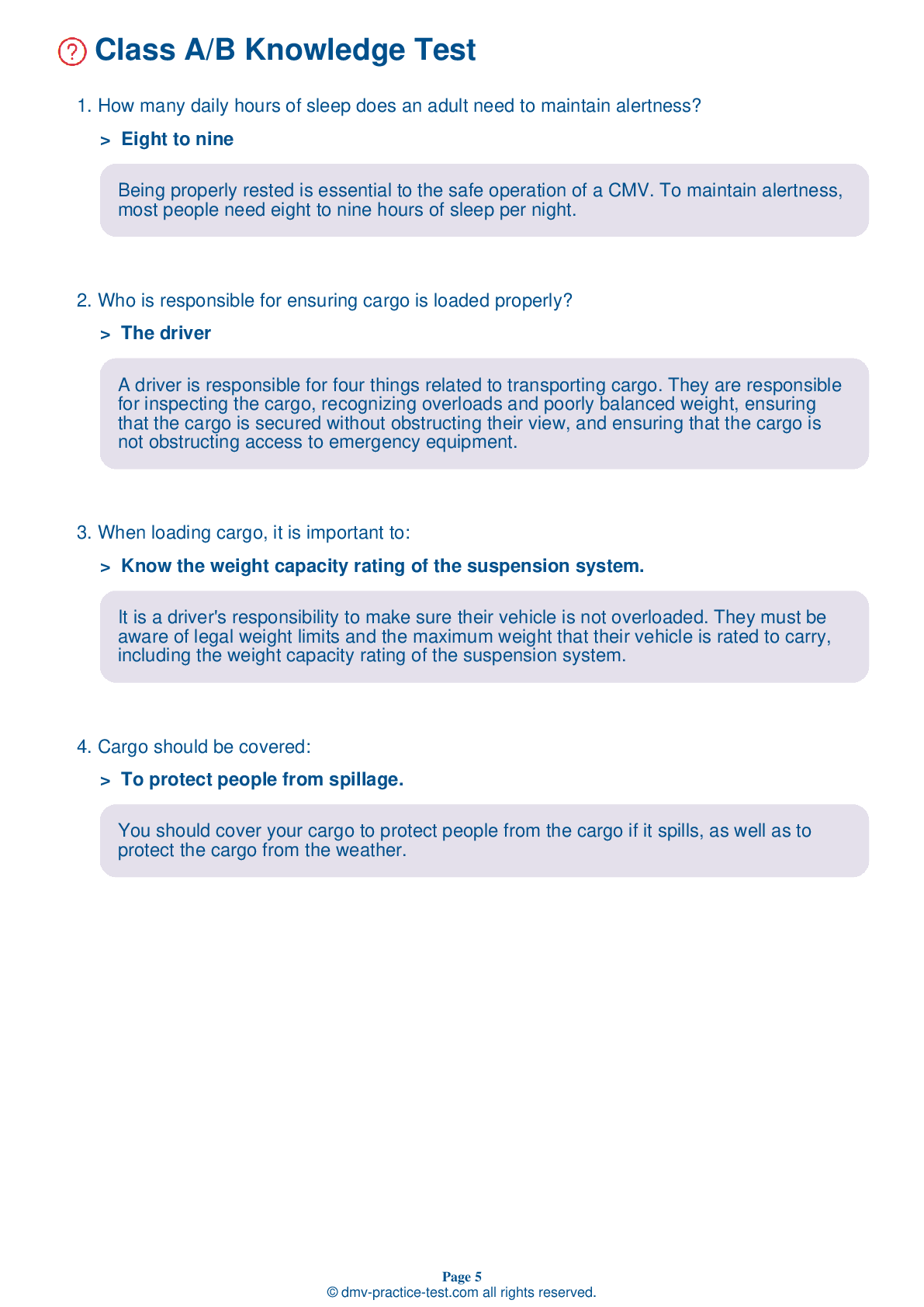Passenger #1
Passenger Endorsement | District Of Columbia 2025 #1
Train for FREE with our District Of Columbia CDL passenger endorsement practice test online. The official exam test consists of several obligatory parts, with all of them checking your knowledge of different blocks of road rules. If you need to obtain a DC DMV passenger endorsement in 2025, practice as much as possible. Free sample tests published on our website will help you check and improve your knowledge and boost your grades. Please bear in mind that DMV requirements for issuing a CDL permit with passenger endorsement may vary from state to state.
20
16
20
1 . When driving a 50-foot truck at 50 mph, you should maintain a following distance of at least:
Eight seconds.
When traveling at speeds below 40 mph, you should maintain at least one second of following distance for every 10 feet of your vehicle's length. At higher speeds, add an additional second.
2 . Your vehicle's final position should be:
Within two feet of the final position described by the examiner.
You should finish each exercise with your vehicle in the exact position described by the examiner. You can be penalized for failing to complete an exercise exactly in the manner described by the examiner, potentially resulting in failure of the basic control skills test.
3 . The minimum tread depth of all major grooves on tires that are not on the front of a CMV should be a minimum of:
3/4 of an inch.
When inspecting your tires, verify that there is at least 4/32 of an inch of tread depth in every major groove on the front tires, and tread depth of at least 2/32 of an inch on the other tires. Tires on the same vehicle should all be the same size.
4 . Which of the following is not an example of a distracted person that motorists should be worried about?
A person sitting on a bench waiting for a bus
Drivers who are holding conversations with others may not be paying full attention to the road and may make unsafe moves. Children do not always pay attention to traffic and may dart into the road without looking. Exercise caution when driving near road workers. This helps to keep the workers and other distracted drivers safe.
5 . A bus driver is:
Not required to wear a seat belt, but is encouraged to do so.
The driver's seat on a bus should be equipped with a seat belt. A driver is always required to wear a seat belt while driving a bus.
6 . When starting the vehicle during the pre-trip inspection, the coolant temperature should:
Jump quickly.
After starting your vehicle during the pre-trip inspection, you should watch the gauges. The coolant temperature should gradually rise to a normal operating range.
7 . If equipped, a header board should:
Light up when the engine is started.
When checking a header board during the vehicle inspection test, you should ensure that it is secure, free of damage, and strong enough to contain cargo.
2025 District Of Columbia | Frequently Asked Questions
In the District of Columbia, a CDL Class A license allows the holder to operate any combination of vehicles with a Gross Combination Weight Rating (GCWR) of 26,001 pounds or more, provided the Gross Vehicle Weight Rating (GVWR) of the vehicle(s) being towed is over 10,000 pounds. This includes tractor-trailers, truck and trailer combinations, and flatbeds.
A Class A CDL license in the District of Columbia permits the holder to operate various types of larger, heavier commercial vehicles. This includes tractor-trailers, truck and trailer combinations, tank vehicles, livestock carriers, and flatbeds. The vehicles can have a Gross Combination Weight Rating (GCWR) of 26,001 pounds or more if the towed vehicle is over 10,000 pounds.
To obtain a Class A CDL license in the District of Columbia, you must be at least 21 years old, possess a valid non-commercial driver's license, pass a vision test, and provide proof of residency and identity. You'll also need to pass written knowledge tests, obtain a Commercial Learner's Permit (CLP), and successfully complete a skills and road test.
In the District of Columbia, you must be at least 21 years old to qualify for a Class A Commercial Driver's License (CDL). This age requirement is consistent across all states and is set by federal regulation. This allows for interstate operation of commercial vehicles. For intrastate (within the same state), the minimum age can be 18.
Specific endorsements are not required for a Class A CDL license but they can provide additional driving privileges. These include endorsements for operating vehicles like school buses, passenger vehicles, tank vehicles, and vehicles carrying hazardous materials. Each endorsement requires passing specific knowledge and skills tests.
The Class A CDL skills test in the District of Columbia consists of three parts: the vehicle inspection test, the basic control skills test, and the road test. The vehicle inspection test involves checking the vehicle's safety components, the basic control skills test assesses your ability to maneuver and control the vehicle, and the road test evaluates your on-road driving skills.
Yes, limitations can be imposed on Class A CDL license holders in the form of restrictions. These are based on the driver's abilities or the type of vehicle they tested in. For example, if a driver takes the skills test in an automatic transmission truck, they will have an 'E' restriction, limiting them to automatic transmission vehicles only.
Yes, it is possible to take the written Class A CDL test in languages other than English in the District of Columbia. However, the Federal Motor Carrier Safety Administration requires all CDL holders to read and speak English sufficiently to converse with the general public, understand highway traffic signs and signals, respond to official inquiries and make entries on reports and records.
Yes, you can request accommodations for the Class A CDL written test in the District of Columbia due to disability. The DMV is committed to providing accessible services and accommodations to individuals with disabilities. You should contact the DMV directly in advance of your test to discuss your needs and the potential accommodations available.
If you don't pass the Class A CDL written test in the District of Columbia, you are allowed to retake it. However, you must wait three days before retaking the test. If you fail the test three times, you must wait 90 days before taking it again. There's also a retesting fee that applies each time.



